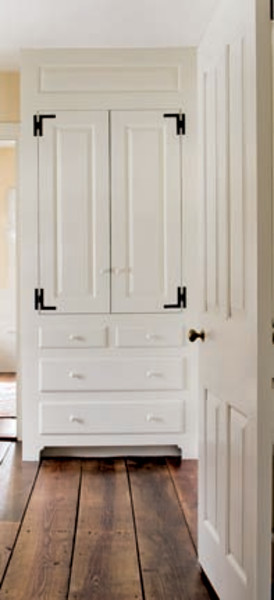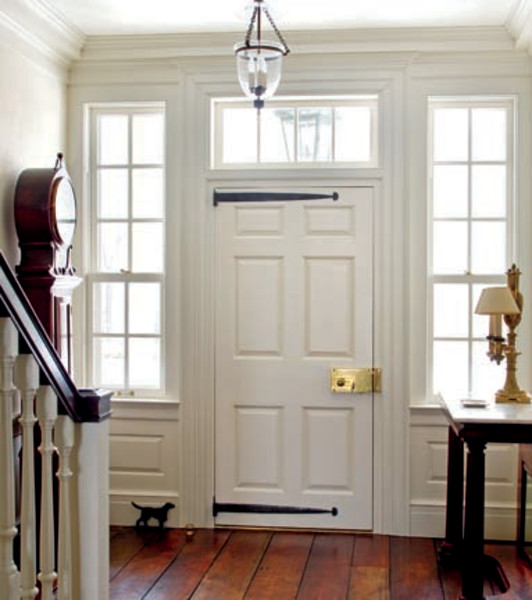
New York architect Gil Schafer collaborated with Historic Housefitters to create period-inspired hardware for a Hudson River Valley country house.
After David and Nancy Sposato married in 1980, they mutually decided to make good on their growing interest in old houses and purchased an old Cape in Putnam County, New York, for the specific purpose of restoring the structure. Without much research or bookwork on the subject, the two spent their nights and weekends attempting to re-create what it was that drew them to the house: a shared interest in authentic period details.
“We just looked around at a lot of old houses,” recalls David, “and it basically came down to certain architectural and design characteristics—not to mention whether it fit into the budget.”
Supported by two full-time jobs, they began on the foundation in the basement and worked their way up—room by room—until final tie-in of the restored chimney into the new roof. “We coined the phrase ‘resto-vating’ because almost everything had to be updated throughout the restoration process,” jokes David.
Of course, this love affair with their home occurred during the pre-Internet era, when one’s selection of materials was usually relegated to the local hardware store. When the couple eventually got around to picking out hardware, they realized their options were limited, choosing instead to seek out a blacksmith to re-create the missing pieces.
A gentleman from Vermont was commissioned and began working on some prototypes. Unfortunately, the wait period was much longer than anticipated, resulting in some unexpected delays. Then, after finally installing everything, some of the pieces didn’t quite fit or work as intended. “That’s when Nancy and I thought there’s got to be an easier way,” says David.
Go with the Flow
Just as they had gone about restoring their Cape, the couple set out with the same fervor in creating a niche hardware business that functioned with higher levels of both period accuracy and customer service. Without any marketing background or experience, they decided to create a catalog of various pieces and advertise in the back of homebuilding magazines. “We literally cut and pasted little pictures of items using type-set format,” admits David. “It was very tedious and time-consuming.” The first publication hit the stands in 1986, establishing Historic Housefitters Company as a one-stop shop for all your period hardware needs.
While Nancy handled the demands of networking contacts, administering contracts, and fine-tuning the details of their commission-based business, David worked on product development—including design, function, and workability. “The goal was to provide quality period pieces with the authentic appearance of a hand-forged item,” says David. “That and a higher level of service for every client.”
Initially, more clients were architects and designers, who were seeking authentic period pieces for their projects. By focusing on the architect/builder relationship, Historic Housefitters was able to create added value for homeowners who had interesting product ideas of their own. “Going in, you think about what or where your business should be,” reflects David. “Ultimately, you end up following the current of where the customers take you.”
Deeper Currents

The work that made Historic Housefitters profitable within three years of initial operations could not have occurred without the skill and pride of the blacksmiths subcontracted to do the work. “A very important part of our company’s business is the strong working relationships with the group of men who are dedicated to producing our own pieces,” notes David.
Many arrived at David and Nancy’s doorstep by word of mouth or in response to the early magazine ad, with most still remaining 20-some years since the company initiated business. Although spread out throughout New England, New York, and down to Virginia, the love of their craft acts as the common denominator that binds them.
“Our business is made up mostly of thumb latches and ‘L’ or ‘H’ hinges,” confesses David, “yet custom work must meet the same standards as volume work. In order to accomplish this, it must come from the same hand, or set of hands, every time so that over time it is consistently the same in appearance and functionality.”
Easier said than done, as most blacksmiths use traditional processes such as coal forges and unique anvils that allow for broad variances in production. Yet it is the time-honored skills that have been passed down from blacksmith to blacksmith that help close the gap on errors. By strictly adhering to correct tooling, they are able to minimize the mechanical tolerances.
In an effort to minimize any potential errors, David spends a lot of time with prospective clients, fleshing out a desired object from peoples’ imaginations. “We produce a lot of drawings to uncover what someone really envisions,” he says. “Then we work directly with each blacksmith involved on the project to review and verify every detail.”
To help in the war against attrition, the company has shifted its concept on product development. By focusing on a higher volume of products per order and reducing the quantity of orders, blacksmiths are able to increase their workload, often resulting in the need for additional workers. “The best economy of scale is volume, and over time, smiths can orient their shops for volume production,” explains David. “But it takes time, so you want to keep them busy.”
Staying the Course
Holding on to that battle cry has been hard over the past year and a half. David bemoans the fact that the company’s volume of business is down almost 25 percent from last year this time, with lead times on production dropping to half of what it originally took. “There is still work to be had,” observes David, “but the projects are not as plentiful as in the past.”
Still, he remains upbeat and optimistic. “We’ll continue to follow the currents, maintaining our strong interest in period work.” Noting a trend moving more toward rustic décor in new old country homes, David eyes another opportunity. “With all the open-hearth kitchens, there is a strong demand for hand-forged fireplace equipment,” he says, excusing himself to work on a new set of sketches.
Stephen T. Spewockis a freelance writer living outside Boston.







